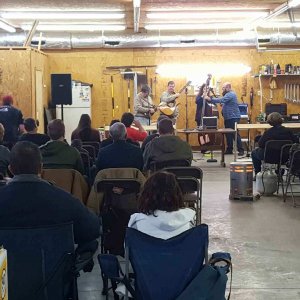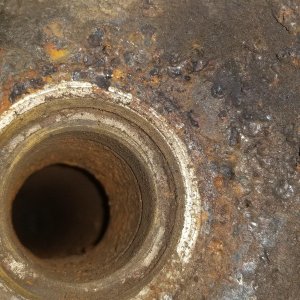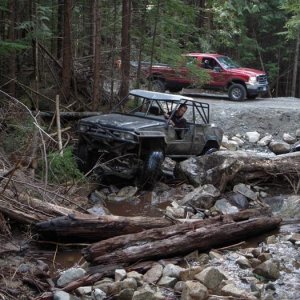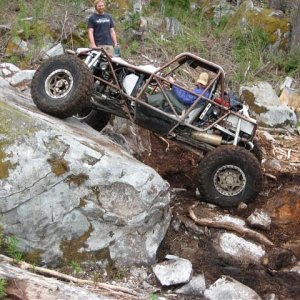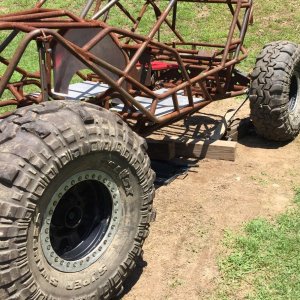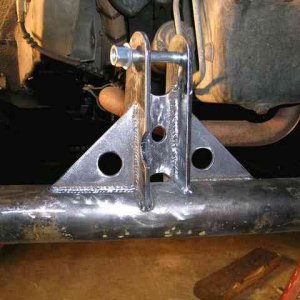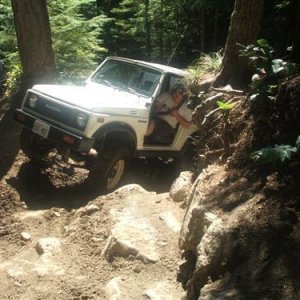-
Help Support Hardline Crawlers :
You are using an out of date browser. It may not display this or other websites correctly.
You should upgrade or use an alternative browser.
You should upgrade or use an alternative browser.
4 link suspension critique
- Thread starter Rjhoward32006
- Start date
clemsonjeep
Well-Known Member
Don't know nearly enough about front setups yet, but the rear looks good. Will the uppers be adjustable? If so I'd set them up so that the numbers you have shown are at the highest hole and allow yourself to work back down towards the 70-80 range. The mid to low 90's work well, but I've also run mine in the mid 80's and been happy with it.
Eddyj
Well-Known Member
I am of no use to you besides a bump.
It's amazing that a year and a half ago this topic actually was the reason I was losing sleep. Once I made my decision on my set up, I literally forgot everything I read over night. I don't know if it is a good or bad trait, but it's how I'm wired. Dive in head first, read everything, do it and move on. Good luck.
P.s. no one gave me much advice that I didnt read ten times. Good luck
It's amazing that a year and a half ago this topic actually was the reason I was losing sleep. Once I made my decision on my set up, I literally forgot everything I read over night. I don't know if it is a good or bad trait, but it's how I'm wired. Dive in head first, read everything, do it and move on. Good luck.
P.s. no one gave me much advice that I didnt read ten times. Good luck
Rjhoward32006
Well-Known Member
I've played with the weight and rolling radious it dosent really affect the #s unless you make a huge change.
TRD
Well-Known Member
- Joined
- Sep 3, 2015
- Messages
- 189
The numbers look good compared to what a lot of people build and run due to fitment issues.
Your roll center angles and heights are all great. If possible I'd drop the AS numbers down a bit.
High AS in the front reduces brake dive and traction.
Your roll center angles and heights are all great. If possible I'd drop the AS numbers down a bit.
High AS in the front reduces brake dive and traction.
clemsonjeep
Well-Known Member
Wouldn't raising the lowers at the rear axle or the uppers at the frame lower the AS number for the rear and also move the IC out closer to the front axle?
Rjhoward32006
Well-Known Member
TRD said:The numbers look good compared to what a lot of people build and run due to fitment issues.
Your roll center angles and heights are all great. If possible I'd drop the AS numbers down a bit.
High AS in the front reduces brake dive and traction.
Now i'm confused, from what i've read 100% AS is neutal over 100 is pushing axles into ground or trying to roll underneath body, which if to high causes wheel hop. And lower than 100 the body squats or axles tries to lift up and loses traction. So idealy i would want close to 100% neutral correct. To help aid in traction but not over 100 to make it wheel hop?
So how does lower AS in the front make for more traction? Not saying your wrong just asking for a explenation so my knowledge of how all this works is increased.
Rjhoward32006
Well-Known Member
Also had the wrong picture for the rear suspension full bump incorrect it is fixed now
Rjhoward32006
Well-Known Member
This is what i started with which i dont understand how it dosent work. The builder of the suspension did exactly what i would have done, he went by the rule of thumb that everyone always claims works best.
Uppers 75% length of lowers. Parallel links/seperation. Perpendicular to the ground.
Plenty of triangulation.
The brackets are btf brackets so the angle of the link were set by those.
Axle end lowers are centerline of axle.
Etc
So how if its built the way eveveryone claims works so well how is it so far off by the calc?
Heres how it was built and currently sits until i change it. This is the rear suspension btw

Uppers 75% length of lowers. Parallel links/seperation. Perpendicular to the ground.
Plenty of triangulation.
The brackets are btf brackets so the angle of the link were set by those.
Axle end lowers are centerline of axle.
Etc
So how if its built the way eveveryone claims works so well how is it so far off by the calc?
Heres how it was built and currently sits until i change it. This is the rear suspension btw

zjtrey
Well-Known Member
The calculator represents theory and basically gives you a way to quantify what you see and feel when you're driving... you plug all these numbers into it and you really have no way of verifying the figures you are entering are 100% correct so at the end of the day its just a starting point and the only way to get the suspension to perform the way you want it is to build it, wheel it and make educated changes using the calculator as reference..
zukimaster
Hold my beer and watch this!
Unless your building a high horse power buggy, or race car, I would not worry about that calculator to much, I built my rear 4 link to be out of the way of rocks and clear everything, and it will climb a wall, but all I do is idle around.
Neal3000
Well-Known Member
I agree with the previous two statements, follow the 4link for dummies guidelines and leave adjustibility in your upper link mounts and all will be good
mac5005
Well-Known Member
Re:
Get the AS down some. Closer to 70 the better, with adjustable frame side upper mounts for 60 and 80.
The higher the AS the more wheel hop you will get in uphill loose, and or dry climbs. The suspension will extend to fight the squat, and eventually remove some weight transfer from rear, the tire will spin and then start that cycle over again causing wheel hop.
Make sure you have plenty of triangulation when viewing the links from the side as well, to counteract what I mentioned above.
Ideally you want the upper links longer that the lowers to keep the pinion pointed at the tcase output through traveling.
Shorter uppers will work against you and point pinion away from tcase through travel, but will help keep the AS consistent through travel. Balance pinion change with AS change through travel by changing upper link length.
Lowering the front AD (AS) will help maintain steering feel when braking. Too much will prevent good weight transfer, creating understeer and poor brake performance
Sent from my SM-G920V using Tapatalk
Get the AS down some. Closer to 70 the better, with adjustable frame side upper mounts for 60 and 80.
The higher the AS the more wheel hop you will get in uphill loose, and or dry climbs. The suspension will extend to fight the squat, and eventually remove some weight transfer from rear, the tire will spin and then start that cycle over again causing wheel hop.
Make sure you have plenty of triangulation when viewing the links from the side as well, to counteract what I mentioned above.
Ideally you want the upper links longer that the lowers to keep the pinion pointed at the tcase output through traveling.
Shorter uppers will work against you and point pinion away from tcase through travel, but will help keep the AS consistent through travel. Balance pinion change with AS change through travel by changing upper link length.
Lowering the front AD (AS) will help maintain steering feel when braking. Too much will prevent good weight transfer, creating understeer and poor brake performance
Sent from my SM-G920V using Tapatalk
TRD
Well-Known Member
- Joined
- Sep 3, 2015
- Messages
- 189
Rjhoward32006 said:Now i'm confused, from what i've read 100% AS is neutal over 100 is pushing axles into ground or trying to roll underneath body, which if to high causes wheel hop. And lower than 100 the body squats or axles tries to lift up and loses traction. So idealy i would want close to 100% neutral correct. To help aid in traction but not over 100 to make it wheel hop?
So how does lower AS in the front make for more traction? Not saying your wrong just asking for a explenation so my knowledge of how all this works is increased.
Your understanding is correct. You want the body to squat because that increases traction. Notice how the flat links make AS 0, somewhere between 0 and 100 is where you want to be.
My old truck was 50% AS in the front and 80% in the rear. It worked well for its time but I think people are running even lower numbers now, especially in the rear.
Rjhoward32006
Well-Known Member
Thanks for the input guys!!!
Rjhoward32006
Well-Known Member
My uppers will be hard to make adjustable but my lowers will be very easy. that's what i've been moving so far.
Will it be okay to do that? Don't see why it wouldnt
Will it be okay to do that? Don't see why it wouldnt
mac5005
Well-Known Member
Re: Re: 4 link suspension critique
It's ok to make the lowers adjustable, just be careful and run the adjustment points through the calculator also
Lower than 60% AS seems to be the trend for West coast stuff and ultra 4,
but typically for East coast type wheeling with more wet muddy waterfall style climbs on low traction surfaces, more AS helps create traction, right up to the point where wheel hop begins.
I shoot for no more that 4 degrees of pinion change each direction.
Just watch out on your adjustment points when you get close, even 1/4" will make a big difference
Rjhoward32006 said:My uppers will be hard to make adjustable but my lowers will be very easy. that's what i've been moving so far.
Will it be okay to do that? Don't see why it wouldnt
It's ok to make the lowers adjustable, just be careful and run the adjustment points through the calculator also
Lower than 60% AS seems to be the trend for West coast stuff and ultra 4,
but typically for East coast type wheeling with more wet muddy waterfall style climbs on low traction surfaces, more AS helps create traction, right up to the point where wheel hop begins.
I shoot for no more that 4 degrees of pinion change each direction.
Just watch out on your adjustment points when you get close, even 1/4" will make a big difference
Rjhoward32006
Well-Known Member
Okay been playing with numbers again.
Travel roll axis. When i plug in my droop or bump numbers. Is this the number of defrees of rear steer basically?
Travel roll axis. When i plug in my droop or bump numbers. Is this the number of defrees of rear steer basically?
clemsonjeep
Well-Known Member
I believe what you're talking about is the box labeled "Roll Axis Angle"







